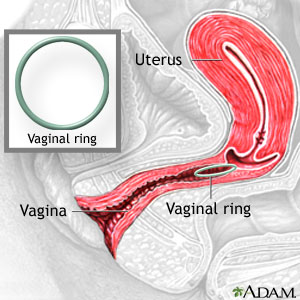WHAT YOU NEED TO KNOW: What is a vaginal ring? A vaginal ring is a small flexible ring that contains medicine. The vaginal ring may be used to prevent pregnancy. It may also be used to treat symptoms, such as vaginal dryness and itching, that occur with menopause. 
|
What do I need to know about the vaginal ring before I use it? You need to see your healthcare provider to get a prescription. Tell your healthcare provider if you are allergic to any medicine. You should not use this medicine if you are breastfeeding or you have vaginal bleeding that has not been checked by a doctor. You should not use the vaginal ring if you have certain medical conditions, such as breast cancer, endometrial cancer, or liver or heart disease. Other medical conditions include severe high blood pressure, circulation problems, and previous stroke or blood clot. You also should not use the vaginal ring if you are a heavy smoker and over the age of 35. Rarely, the vaginal ring may increase your risk for blood clots, heart attack, stroke, and toxic shock syndrome. How do I use my vaginal ring? Your healthcare provider will tell you when you can start using the vaginal ring. He will also show you how to put in your vaginal ring. You should receive another information sheet from your healthcare provider or pharmacist about this medicine. Read the information, and talk with your healthcare provider if you have questions. It is very important to use your vaginal ring exactly as directed. - If you are using the vaginal ring as birth control, keep it in place for 3 weeks in a row. Take your ring out for a 1-week break. When the week has gone by and you have probably had your menstrual period, place a new ring into your vagina.
- If you are using the vaginal ring for menopause symptoms, keep the ring in place for 90 days (3 months). After 3 months, take out your old ring and put in a new one.
How do I insert my vaginal ring? - You may lie down, stand with one leg up, or squat when you insert the ring. Choose a position that feels best to you.
- Wash your hands with soap and water. Dry your hands. Remove your vaginal ring from its pouch.
- Press the sides of the ring together with your thumb and pointer finger.
- Push the ring high up into your vagina like a tampon.
- When your vaginal ring is in place, you should not feel anything. If you feel discomfort when the ring is in place, it may not be far enough inside your vagina. Gently use your finger to push the ring higher into your vagina. It is important that your vaginal ring is placed in the upper part of the vagina.
- You do not have to worry that you will push the ring up too far or that it will get lost. Your cervix (the narrow, lower end of your uterus) will block the ring from going too high in your vagina.
- If the ring slips down into your lower vagina, use your finger to push it back up. If the ring comes completely out, rinse it in warm (not hot) water and put it back in.
How do I take out my vaginal ring? - Wash and dry your hands.
- You may lie down, stand with one leg up, or squat when you remove the ring. Choose a position that feels best to you.
- Use your finger to hook the ring and gently pull it out. Do not flush the old ring down the toilet. Throw the ring away where children or pets cannot get to it.
When should I contact my healthcare provider? - You are bleeding from your vagina and you do not know why.
- Your vaginal ring causes itching, pain, or burning.
- You have stomach pain or tenderness, or you are vomiting.
- You have trouble sleeping, feel tired, or your mood changes.
- You have questions or concerns about your condition or care.
When should I seek immediate care or call 911? - Your arm or leg feels warm, tender, and painful. It may look swollen and red.
- You feel lightheaded, short of breath, and have chest pain.
- You cough up blood.
- You have any of the following signs of a stroke:
- Numbness or drooping on one side of your face
- Weakness in an arm or leg
- Confusion or difficulty speaking
- Dizziness, a severe headache, or vision loss
|